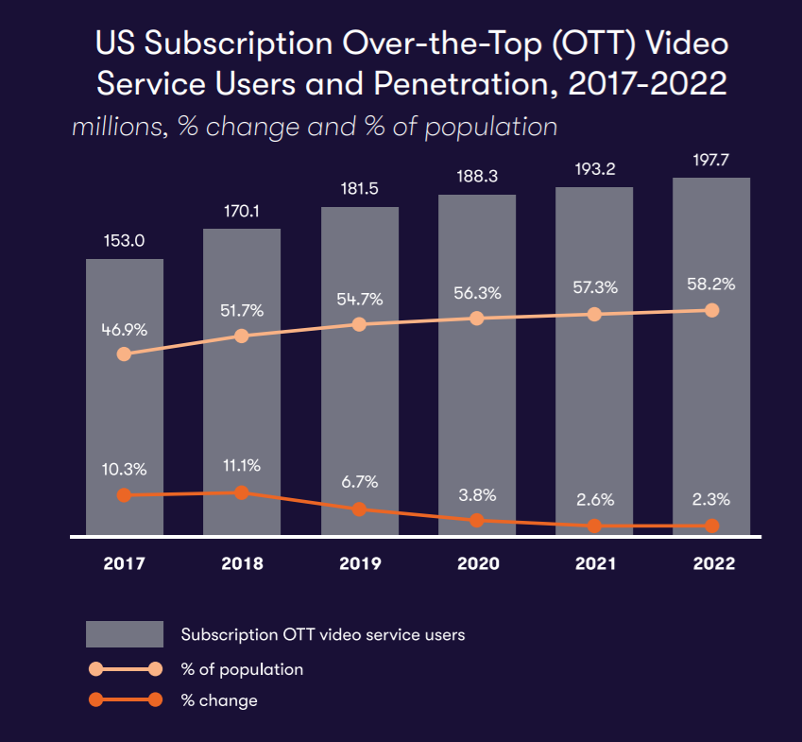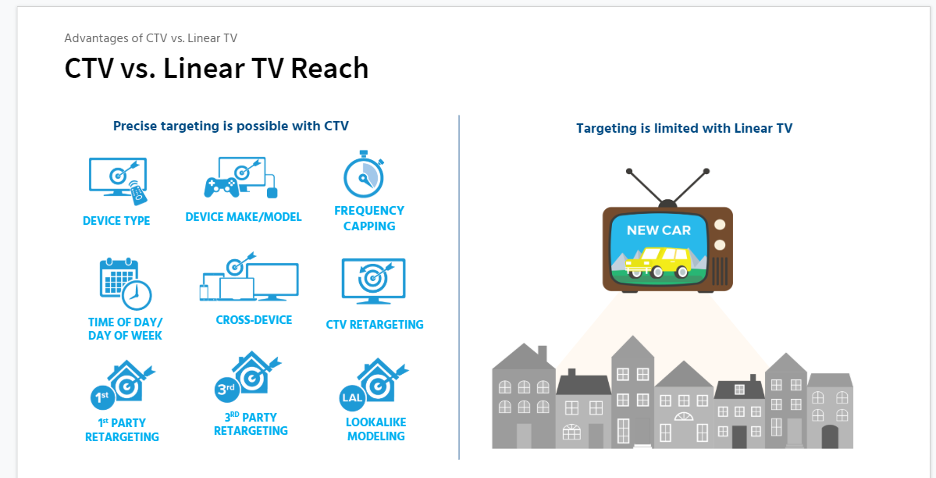In the past decade, there’s been a major shift in the way we consume TV and entertainment.
In 2018, The IAB Video Landscape Report found that around 13.5 million households have abandoned traditional TV consumption due to the broad use of internet-powered television, or Smart TV. And with COVID-19 keeping people at home, Conviva reports that streaming time is up 26% in the US and 20% globally.
As cable growth is slowing and linear viewership is becoming fractured, advertisers have the opportunity to get more creative with targeted messaging via connected TV (CTV).
Savvy agencies and trading desks are leveraging CTV to reach their ideal audience and boost brand engagement.
In this guide, we’ll walk you through what connected TV ads are, the benefits of connected TV advertising, how to get started using connected TV ads and some channels we recommend capitalizing on.
What Exactly is Connected TV? Examples and Explanations of Common Terms
Connected TV specifically refers to televisions that have access to an internet connection and can load or stream digital content.
This can include Smart TVs (where internet connection is built-in), but it can also include standard TVs that are connected to the internet via smart devices. Smart devices include gaming consoles like Xbox and Playstation, dongles like Roku or Chromecast and internet-capable DVD players.
OTT (Over the Top)
Over the top (OTT) is often used synonymously with CTV. It refers to TV-like content that is distributed over the internet.
The main difference between OTT and CTV is as follows:
- CTV is the umbrella technical term relating to all advertising on internet-capable TV devices, whereas;
- OTT refers to any TV-like content delivered over the internet that can be accessed from any internet-capable app or device (i.e. smartphones, tablets, etc.)
OTT is a relatively new distribution model that allows for content to be streamed through an internet connection instead of through a traditional cable or broadcast provider.
US subscriptions for OTT video service have skyrocketed over the past few years. And projected insights see a continuous gradual rise looking forward.
According to an IAB UK Report, in 2017, 46.9% of the population had an OTT video service subscription, up 10.3% from the year before. By 2022, it’s projected that 58.2% of the US population will be streaming video via OTT and Smart TV.

The three types of OTT providers are:
- Subscription video on demand (SVOD): These are streaming services that require a subscription, such as Netflix, Hulu and Amazon Prime Video. They typically don’t run ads or only run them on an unpaid subscription model.
- Advertising-based video on demand (AVOD): These are free streaming services that operate based on revenues they generate from ads. Examples of AVOD include Crackle, Tubi and Vudu.
- Multichannel video programming distributors (vMVPDs): These are streaming service providers that have paid-TV programming. Examples of vMVPDs include AT&T Now, Sling and YouTube TV.
Another important term is Full-Episode Player (FEP), which refers to professionally produced, TV-like content.
For example, Handmaid’s Tale (FEP) plays on Hulu (OTT), which is a subscription-based video-on-demand service (SVOD), via an Amazon Fire TV Stick (CTV).
By placing ads on these OTT services (which are available through connected TVs), marketers can reach audiences that are no longer available through traditional cable TV.
Types of Connected TV Ads
There are three main types of connected TV ads.
- In-stream video ads are unskippable 15- to 30-second long ads that play before or during the program. They are a clever and cost-effective way to reuse your existing television ads for connected TV.
- Interactive Pre-Roll ads are like in-stream video ads, except they allow the viewer to click through to a landing page. For example, if you’re advertising a movie, this type of ad could bring the viewer to a page where they could book a ticket.
- Home Screen Placement ads are stagnant ads that sit on the home screen. They’re typically a short video or image and can feature a call to action like ‘learn more’.
Reed, a recruitment firm based in the UK, created a clever interactive pre-roll ad targeted at people watching OTT at work.
With a compelling, funny call-to-action, it engages its target audience and gives them the option to click and learn more.
Although these are the main categories – your content delivery options vary depending on the OTT service, device, channel and platform you choose to work with.
Eight Benefits of Connected TV Advertising
Connected TV advertising is one of the most effective ways to reach your audience. They are more targeted, measurable, cost-friendly and on-trend with consumer behavior than linear TV advertisements.
With traditional TV advertisements, you can only target based on context. With CTV, not only can you control and know exactly the profile of audience who is viewing your ads, you can also buy ads in packages and serve them via powerful ad formats throughout the buyer journey in a trackable way.
All in all, CTV advertising is a major upgrade when compared to linear. Excited yet? Great, let’s dive in.
1. Budget-Friendly
Connected TV advertising is cost-effective because of precise targeting. Instead of advertising during a sports game in the hopes that you’ll reach males 25-39 who like corvettes, you can actually specifically target this demographic. Every cent of your ad dollars goes towards your intended target.
Plus when an ad is shown on a connected TV, there’s a higher chance that more than one person will see it since people typically watch TV with family or friends.
This is in contrast to when people watch on personal devices – which is typically only meant for one viewer at a time. In this way, it reduces the cost per impression for the advertiser.
2. Improved Viewability
Viewability is the measurement of how many target users actually saw your ad, not simply how many times an ad has loaded. In the case of CTV ads, an ad is only considered viewable if the video actually plays. It is also possible to track how long the user allows the ad to play for.
In other words, you really know how much traction your ad is getting and you can optimize for enhanced brand awareness.
What’s more, CTV viewers watch on-demand, meaning they are more engaged when watching. This is a strength of CTV as compared to regular display ads or traditional TV, where it is quite natural for users to tune out images or long commercial breaks.
3. Variety of Ad Formats
CTV advertising allows marketers to experiment with a variety of ad formats. You can split test and discover which ad formats and call-to-actions work best to drive engagement and improve ad performance.
Interactive video, call-to-action, animated and static ad types are all formats marketers can utilize. As long as you follow the best practices for all screen types (i.e. smart TV, laptop, tablet and mobile), you can display next-level, unforgettable ad experiences.
4. Premium & Responsive Audiences
Connected TV ads can be run during times when audiences are highly engaged. This might include sporting events, live concerts or season finales. Placing ads at these times allows marketers to reach unique audiences and have a high potential of seeing an impressive return on investment.
Premium audiences and smart TV users also have more control over how to consume and interact with ads, which leads to higher levels of satisfaction and positive feelings towards the advertised content.
5. Premium Inventory and Publishers
CTV ads can be run on most major networks, including NBC, ESPN, Fox, and more. These major networks are no longer only displaying traditional, linear TV-style ads.
Moreover, CTV ads are available via premium publishers like Hulu, Vevo, Fire TV, Tubitv and Vudu, to name a few.
This means that the inventory opportunities are huge, both from a buyer and publisher standpoint. Major networks and publishers understand that CTV has grown tremendously in the past few years and are investing in this growing trend.
6. Real-Time Metrics
CTV ads can be measured and optimized in real-time. This ability allows marketers to uncover insights on a user’s path to conversion, learn more about audiences or geographies most likely to convert, and map to other devices in the same household using the IP address (laptops, tablets, mobile).
Key connected TV metrics include:
- Impressions Delivered: This metric represents the number of single ads that were served to a user. To be counted as an impression, an ad only has to be placed on the page and potentially visible to a user. If the ad is at the bottom of the page or isn’t clicked, it still counts as an impression.
- View-Through Conversions: This conversion represents when a user views your ad and does not interact with it – but they went on to convert at a later time.
- Video Completion Rate (VCR): VCR is the percentage of impressions in the campaign that completed the ad to the end. CTV is notable for its high VCR rates.
- Frequency: Frequency is calculated by taking the total number of impressions and dividing by the number of unique persons or households who viewed your ad. The resulting number is the average number of times you’re delivering a CTV ad to a given household.
7. Sports-related streaming is on the rise
Although sports viewers are least likely to “cut the cord” with linear TV, statistics show that sports-related streaming is on the rise.
Among US fans who use a streaming service to watch sports, 57% report doing so to gain access to games that aren’t available through cable, and 38% say that streaming is less expensive than satellite or cable Pay-TV.
And with the absence of live games in response to COVID-19, sports fans and viewers are currently consuming more sports-related news than before.
This presents a huge opportunity for CTV advertising through OTT providers and smart TVs. If sports-related streaming is increasing when there aren’t even any games, imagine the spike in demand that will take place when live sports eventually resume.
8. Precise Audience Targeting

Because CTV often requires users to log in with Facebook or Google accounts, marketers can gather additional user information such as zip code, interests, online behavior, device use and primary language to make highly targeted campaigns.
Advertisers can also target by device type, time-of-day, CTV retargeting, 1st party retargeting, 3rd party retargeting and lookalike modeling. These are all methods of strategically re-displaying your ads to users who have already shown an interest in your brand, or a similar brand, to boost awareness and ultimately drive conversions.
CTV retargeting is smarter than standard practices, as it allows you to display re-targeted ads specifically when and where your target audience is using a CTV or OTT service. Where traditional TV ads are served to millions of people who may or may not be interested in what your ad has to say, CTV retargeting hones in on users who are more likely to engage.
By optimizing with targeting, marketers can reach ideal audiences, save money, achieve a higher ROI and build brand recognition with compelling messaging.
How to Get Started with Connected TV Ads
At the start, launching a CTV campaign is no different than planning a traditional advertising strategy. You need to set marketing objectives, define your goals and create a plan to achieve them. When ready, the next step is to choose a CTV vendor.
Here’s a step-by-step rundown:
Define Your Target Audience
When planning to buy a CTV ad, the first thing to think about is your target audience. You should break down each segment of your audience by these three main categories:
- Demographics: This could include your audience’s age, location and income.
- Interests: Think more broadly about your audience by considering their preferred recreation, personal goals, desires and family life.
- Purchasing Behavior: Knowing what information your audience likes to have before making buying decisions. Understand where they are in the buyer’s journey so you can improve your messaging.
Decide What Ad Inventory & Creatives to Use
With your audience defined, think about where to best find that audience with ad inventory. For example, you might choose a network or app that’s accessed through smart TVs or OTT devices like CNN, ESPN or the Discovery Channel. Or you could choose a device with connected TV streams like Apple TV, Roku or Chromecast.
For example, Baskin Robins created an ad and displayed it on both linear TV and via OTT on Roku (CTV).

86% of viewers who saw the ad on Roku did not see the ad on linear TV. This lead to a 10.6% incremental reach.
Once ad inventory is decided, select which engaging and eye-catching ad creative you’ll use. Review your past paid media and decide which creative will resonate best with your target audience.
Take Note of Your Metrics and Benchmarks
As your metrics come in, you’ll be able to set performance benchmarks. Use these benchmarks to split test your creatives and compare for future experiments so you can continue to tweak and improve your campaigns.
Compare and Select Your Connected TV Vendor
With a structure in place, you’ll need the right technology to support it. There are several options out there, each with their own features and track record.
First, you should decide whether or not you’ll be working with Demand-side platforms (DSPs) or if you’ll invest in a trading desk.
The key differences between the two are as follows:
- Demand-Side Platform (DSP): DSPs are used by advertisers and agencies to manage and purchase inventory from multiple ad networks through a central interface. DSPs can help target specific users based on information such as their location and browsing behavior, while still allowing marketers to buy impressions from a range of publisher sites. Different DSPs have different strengths and capabilities.
- Trading Desk : Trading desks help centralize the buying and optimization of “programmatic” or “biddable” media. They work to help clients improve their advertising performance and receive increased value from their ad buys. They also measure results and provide helpful reporting so their clients are aware of important metrics and potential areas for improvement.
If you have a large and well-resourced team, you can likely manage several DSPs at once. Companies that don’t have well-resourced teams or want their teams to spend less time on managing DSPs often opt to seek out trading desks instead.
Trading desks work to bring the accessibility of several DSPs together while still capitalizing on the benefits of automation that programmatic has to offer. Trading desks also have access to historical bidding data, optimization algorithms and other helpful metrics that can inform ad-buying decisions.
Before deciding between DSPs or trading desks, compare the following information: cost, transparency, data, ease of use, customer support, what reporting is offered and if it’s a natural business model fit.
Conclusion
With CTV, OTT and TV viewership shifting, advertisers are finding that they need to change how they approach their advertising strategies. Estimates by eMarketer suggest that US advertisers will spend $6.94 billion on CTV ads this year, and will grow to $14.12 billion by 2023.
Changes in the technological landscape combined with the perks of CTV ads make it clear that this form of programmatic advertising is not only here to stay, but will continue to grow rapidly.
Overall, there’s never been a better time to start capitalizing on connected TV and video advertising.
Images:
Image 1: IAB
Image 2: Acquisio
Image 3: iSpot.tv
